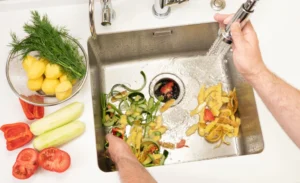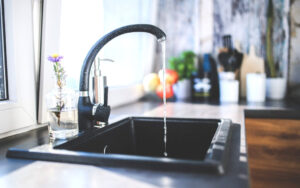Garbage Disposal Not Working? Here’s What to Do A malfunctioning garbage disposal can be a major inconvenience in any kitchen. Whether it’s failing to turn on, making strange noises, or not grinding food properly, addressing the problem quickly is crucial.
Here’s a comprehensive guide to help you diagnose and fix common garbage disposal issues.
Understanding the Basics of a Garbage Disposal
Before diving into troubleshooting, it’s important to understand the basic components of a garbage disposal and how it works. A typical garbage disposal unit consists of:
Motor: Powers the grinding mechanism.
Impellers (or Blades): Spin rapidly to chop up food waste.
Grinding Chamber:
Contains the impellers and helps grind food.
Flywheel: A rotating disk that the impellers are attached to.
Reset Button: A safety feature that trips the unit if it overheats or jams.
Common Garbage Disposal Problems and Solutions

1. Disposal Not Turning On
Symptoms:
No sound when the switch is flipped.
No humming noise.
Possible Causes:
Power supply issues.
Tripped circuit breaker.
Internal electrical problems.
Steps to Fix:
Check the Power Connection:
Ensure the disposal is plugged in securely.
If it’s hardwired, inspect the connections for any loose wires.
Reset the Disposal:
Locate the reset button on the bottom or side of the unit. Press it firmly. If it’s tripped, you might hear a click.
Try turning on the disposal again.
Check the Circuit Breaker:
Go to your home’s electrical panel and see if the breaker for the kitchen or disposal has tripped. If so, reset it.
Inspect the Wall Switch:
Sometimes the wall switch can fail. Test the switch by using a voltage tester or temporarily replacing it with a known working switch.
2. Disposal Hums but Doesn’t Grind
Symptoms:
A humming noise when the switch is flipped.
No grinding action.
Possible Causes:
Jammed flywheel.
Motor issues.
Steps to Fix:
Turn Off Power:
Ensure the disposal is off and unplugged. If it’s hardwired, turn off the breaker.
Use a Wrench:
Most disposals come with an Allen wrench (or hex key) that fits into a slot at the bottom of the unit. Insert the wrench and turn it back and forth to free the flywheel.
Alternatively, use a broom handle or plunger stick to manually rotate the impellers from the top.
Remove Obstructions:
Use tongs or pliers to remove any visible debris from the grinding chamber.
Never use your fingers to avoid injury.
Reset and Test:
After clearing the jam, press the reset button and test the unit.
3. Disposal Leaks
Symptoms:
Water pooling under the sink.
Drips from the disposal unit.
Possible Causes:
Loose connections.
Damaged gaskets or seals.
Cracked disposal housing.
Steps to Fix:
Identify the Leak Source:
Turn off the water and run the disposal. Check for leaks from the sink flange, dishwasher connection, or drain pipe.
Tighten Connections:
Use a wrench to tighten any loose connections. Check the mounting ring and flange for secure attachment.
Replace Gaskets or Seals:
If the leak is coming from the gasket or seal, you may need to replace these components. Consult your disposal’s manual for specific instructions.
Check for Cracks:
Inspect the disposal housing for any visible cracks. If the housing is damaged, the unit may need to be replaced.

4. Disposal Drains Slowly
Symptoms:
Water backing up into the sink.
Slow draining water.
Possible Causes:
Clogged disposal or drain pipe.
Blocked P-trap.
Steps to Fix:
Flush with Water:
Run cold water through the disposal to help clear minor clogs.
Use a Plunger:
Use a sink plunger to dislodge clogs. Ensure the other sink drain is plugged if you have a double sink.
Clean the P-trap:
Place a bucket under the P-trap (the curved pipe beneath the sink). Unscrew the nuts and remove the trap. Clean out any debris and reassemble.
Conclusion
A malfunctioning garbage disposal can disrupt your daily routine, but many common issues can be resolved with a bit of troubleshooting and maintenance. By understanding the typical problems and their solutions, you can keep your disposal running smoothly and extend its lifespan. Regular maintenance and mindful usage are key to avoiding future problems, but don’t hesitate to call a professional if the issue seems beyond your capabilities. With these steps, you’ll be better equipped to handle any garbage disposal malfunction that comes your way.
Read Also .How to Install a Dimmer Switch with 2 Wires